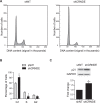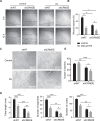Transcriptome analysis-identified long noncoding RNA CRNDE in maintaining endothelial cell proliferation, migration, and tube formation
- PMID: 31863035
- PMCID: PMC6925215
- DOI: 10.1038/s41598-019-56030-9
Transcriptome analysis-identified long noncoding RNA CRNDE in maintaining endothelial cell proliferation, migration, and tube formation
Abstract
Obesity is a leading risk factor for type-2 diabetes. Diabetes often leads to the dysregulation of angiogenesis, although the mechanism is not fully understood. Previously, long noncoding RNAs (lncRNAs) have been found to modulate angiogenesis. In this study, we asked how the expression levels of lncRNAs change in endothelial cells in response to excessive palmitic acid treatment, an obesity-like condition. Bioinformatics analysis revealed that 305 protein-coding transcripts were upregulated and 70 were downregulated, while 64 lncRNAs were upregulated and 46 were downregulated. Gene ontology and pathway analysis identified endoplasmic reticulum stress, HIF-1 signaling, and Toll-like receptor signaling as enriched after palmitic acid treatment. Moreover, we newly report enrichment of AGE-RAGE signaling pathway in diabetic complications, IL-17 signaling, and cysteine and methionine metabolism by palmitic acid. One lncRNA, Colorectal Neoplasia Differentially Expressed (CRNDE), was selected for further investigation. Palmitic acid induces CRNDE expression by 1.9-fold. We observed that CRNDE knockdown decreases endothelial cell proliferation, migration, and capillary tube formation. These decreases are synergistic under palmitic acid stress. These data demonstrated that lncRNA CRNDE is a regulator of endothelial cell proliferation, migration, and tube formation in response to palmitic acid, and a potential target for therapies treating the complications of obesity-induced diabetes.
Conflict of interest statement
The authors declare no competing interests.
Figures






Similar articles
-
Long noncoding RNA CRNDE promotes colorectal cancer cell proliferation via epigenetically silencing DUSP5/CDKN1A expression.Cell Death Dis. 2017 Aug 10;8(8):e2997. doi: 10.1038/cddis.2017.328. Cell Death Dis. 2017. PMID: 28796262 Free PMC article.
-
CRNDE, a long non-coding RNA responsive to insulin/IGF signaling, regulates genes involved in central metabolism.Biochim Biophys Acta. 2014 Feb;1843(2):372-86. doi: 10.1016/j.bbamcr.2013.10.016. Epub 2013 Nov 1. Biochim Biophys Acta. 2014. PMID: 24184209
-
The Long Non-Coding RNA CRNDE Promotes Colorectal Carcinoma Progression by Competitively Binding miR-217 with TCF7L2 and Enhancing the Wnt/β-Catenin Signaling Pathway.Cell Physiol Biochem. 2017;41(6):2489-2502. doi: 10.1159/000475941. Epub 2017 May 4. Cell Physiol Biochem. 2017. PMID: 28472810
-
CRNDE: A Pivotal Oncogenic Long Non-Coding RNA in Cancers.Yale J Biol Med. 2023 Dec 29;96(4):511-526. doi: 10.59249/VHYE2306. eCollection 2023 Dec. Yale J Biol Med. 2023. PMID: 38161583 Free PMC article. Review.
-
Contribution of CRNDE lncRNA in the development of cancer and the underlying mechanisms.Pathol Res Pract. 2023 Apr;244:154387. doi: 10.1016/j.prp.2023.154387. Epub 2023 Feb 24. Pathol Res Pract. 2023. PMID: 36893710 Review.
Cited by
-
Sitagliptin Ameliorates Creb5/lncRNA ENSMUST00000213271-Mediated Vascular Endothelial Dysfunction in Obese Mice.Cardiovasc Drugs Ther. 2024 Aug;38(4):679-691. doi: 10.1007/s10557-023-07436-1. Epub 2023 Feb 4. Cardiovasc Drugs Ther. 2024. PMID: 36738369
-
Targeting the epigenome in in-stent restenosis: from mechanisms to therapy.Mol Ther Nucleic Acids. 2021 Jan 26;23:1136-1160. doi: 10.1016/j.omtn.2021.01.024. eCollection 2021 Mar 5. Mol Ther Nucleic Acids. 2021. PMID: 33664994 Free PMC article. Review.
-
Knockdown of lncRNA HOXA-AS3 Suppresses the Progression of Atherosclerosis via Sponging miR-455-5p.Drug Des Devel Ther. 2020 Sep 9;14:3651-3662. doi: 10.2147/DDDT.S249830. eCollection 2020. Drug Des Devel Ther. 2020. PMID: 32982172 Free PMC article.
-
Targeting Insulin Resistance, Reactive Oxygen Species, Inflammation, Programmed Cell Death, ER Stress, and Mitochondrial Dysfunction for the Therapeutic Prevention of Free Fatty Acid-Induced Vascular Endothelial Lipotoxicity.Antioxidants (Basel). 2024 Dec 5;13(12):1486. doi: 10.3390/antiox13121486. Antioxidants (Basel). 2024. PMID: 39765815 Free PMC article. Review.
-
Role of lncRNAs in pathophysiology of obesity.Curr Opin Physiol. 2025 Jun;44:100832. doi: 10.1016/j.cophys.2025.100832. Epub 2025 May 8. Curr Opin Physiol. 2025. PMID: 40823284
References
Publication types
MeSH terms
Substances
Grants and funding
LinkOut - more resources
Full Text Sources
Molecular Biology Databases
Research Materials

